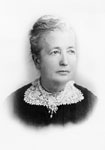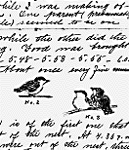Althea Sherman Resurrected
By Connie Fleischer Mutel '69
 In 1895 42-year-old Althea Sherman quit her job as an art teacher
to return to the family farm in northeastern Iowa and care for
her ailing parents. Both were dead within seven years, but Althea
stayed on, cooking and keeping house for her crotchety, miserly
sister, a horse-and-buggy physician who had also returned to the
family homestead, taking on the then-masculine role of chief breadwinner.
The sisters sequestered themselves for decades thereafter, watching
as the nearby village of National shriveled into a ghost town,
centering their lives around the dooryard outside the kitchen
window.
In 1895 42-year-old Althea Sherman quit her job as an art teacher
to return to the family farm in northeastern Iowa and care for
her ailing parents. Both were dead within seven years, but Althea
stayed on, cooking and keeping house for her crotchety, miserly
sister, a horse-and-buggy physician who had also returned to the
family homestead, taking on the then-masculine role of chief breadwinner.
The sisters sequestered themselves for decades thereafter, watching
as the nearby village of National shriveled into a ghost town,
centering their lives around the dooryard outside the kitchen
window.
Althea was 90 years old when she died in 1943. Her life could
be cast as a tale of unfulfilling isolation, of a woman whose
family duties robbed her of the chance to shape and express her
own desires. Nothing could be further from the truth.
In the one-acre dooryard where she pumped water and hung out clothes,
she began observing the natural world with increasing interest.
Soon her passions were focused on the 162 species of birds that
fluttered near her back door and in the adjacent marsh, and on
the winged newcomers that moved into the deserted houses nearby.
She started building nest boxes for them--strange nest boxes with
peepholes for observing their inhabitants and ports to remove
babies for weighing or painting or for medical care.
Althea's studies absorbed all her time--other than that needed
for the barest necessities--and from spring to fall migration,
her life became one with the birds. She watched and recorded from
dawn to dusk or, when focusing on an owl, until well past midnight.
"Every phase of Flicker nest life passed within view," she wrote
of one her favorite species, "during which time I combed my hair,
ate my meals, and once dressed for a visit to the county seat."
Her precise, meticulous observations covered first a few pages,
then entire notebooks, with exacting explanations of what young
birds were fed, when and how often, by whom, how their weight
and size increased, and the like. Soon she was joining respected
scientific societies, 15 in all, and writing paper after paper
for professional journals. Although she had no formal training
in science, Althea became a leading ornithologist, one whose work
is yet to be contradicted by contemporary experts.
When she died she left 60 closely written notebooks on her shelves,
along with a wish that someone shape her writings into a book.
A friend obliged, and Birds of an Iowa Dooryard was published
in 1952, an 18-chapter tribute to Althea's nearly 40 years of
absorbed, painstakingly accurate work. Useful to the serious student
of ornithology, the amateur bird watcher, and anyone interested
in humankind's interaction with the natural world, the book was
republished last October by the University of Iowa Press.
The detail of Sherman's writing would be overwhelming were it
not for her strong voice and wit. She records, for example, that
in one busy day "118 lice [were picked] from one little Phoebe
that weighed 161 grains and whose entire body scarcely equaled
one-half the size of one's thumb." But the author's humor and
style suffuse the detail, making the slightest incident in a young
bird's life a well-told drama. Who could fail to transform their
concept of night after reading that ". . . the Chickadee is well
sheltered in the feather-lined nest of a House Wren . . . and
we may be equally confident that Nuthatches and Downy Woodpeckers
are comfortably housed in holes in the trees."
Althea was not without her idiosyncrasies. She did not hesitate
to judge birds as good (prey species) or bad (predators or pests).
She candidly admitted how she molded the bird life around her
house. When the predatory kestrel--a bad bird--first nested nearby,
she gave them "a trial . . . to watch closely their relations
with other birds." The nestlings' fate rested on their parents'
behavior. She extended her vendetta against the house wren, which
pierces and destroys the eggs of other native species, beyond
her life span by stipulating that whoever inherited her house
should not allow wrens to nest on the property.
While the book will interest serious students of birds, I gravitated
to another feature--Althea's knack for weaving together minute
detail, the broader picture of a species' ecology, and changes
in the Iowa countryside in the early 1900s. Many of these changes
must have been obvious to Althea, the daughter of pioneers who
built one of the first houses on the prairie near Dubuque. When
her memory did not stretch back far enough, she found it "desirable
to question men of eighty years or upward, who were familiar with
farming operations of long ago," dryly adding, "I began none too
soon, since now all my informants are dead."
Althea watched the surrounding terrain evolve from treeless grassland
to agricultural land and patchy forest, noticing that cardinals,
flickers, and red-headed wood-peckers followed homesteads and
trees onto former prairies, and that the bronzed grackle population
increased when conifers were planted. But she did more than observe;
she recognized the relationship between en-croaching civilization
and changing natural habitats long before others made the connection.
"Never before in our immediate neighborhood . . . had Sparrow
Hawks nested, yet for years man and nature had been at work preparing
the way for them."
 Althea's records still provide unique insights, reminding us that
the natural world is far from static. Her record of the transformations
of 100 years ago can help us deduce the future effects of humans
on local and global environments. Her astute comments elucidated
how diminishing biodiversity and habitat are tied to our lifestyles.
Commenting on the impact of plowing, mowing, and grazing on birds
such as the bobolink, she wrote, "If long ago everyone had become
a vegetarian . . . if chemists had placed on the market synthetic
butter, milk, cheese, and ice cream, the ground nesting birds
would not have fared so badly."
Althea's records still provide unique insights, reminding us that
the natural world is far from static. Her record of the transformations
of 100 years ago can help us deduce the future effects of humans
on local and global environments. Her astute comments elucidated
how diminishing biodiversity and habitat are tied to our lifestyles.
Commenting on the impact of plowing, mowing, and grazing on birds
such as the bobolink, she wrote, "If long ago everyone had become
a vegetarian . . . if chemists had placed on the market synthetic
butter, milk, cheese, and ice cream, the ground nesting birds
would not have fared so badly."
I came away from Birds of an Iowa Dooryard with a new sense of
intimacy with birds and a deeper understanding of ecological processes.
I also made a new and inspiring friend. For although Althea's
writings are largely scientific, her character runs through them
as clear as a silvery river. A strong-willed woman, she devoted
her life to understanding, illuminating, and defending the animals
she loved. That passion infuses every chapter, reminding us of
the value of intense dedication, of the rewards of the life lived
beyond the orderly and conventional.
She also taught me something about aging. Here was a woman whose
life essen-tially began after societal duties to family had ended,
when many recline into passivity. Althea was past 50 when she
began most clearly to follow her own path and shape it into her
own unique ex-ploration of worth. Such a treatise cannot help
but inspire today's baby boomers, who are at the age Althea was
when she returned to her family homestead.
Althea embodied our notion of a life grounded in the natural world
at our doorsteps, where we can find intensity and richness beyond
the wildest expectations. We could use such grounding in our modern
fast-paced lives--so could the birds, worms, mushrooms, frogs,
mosses, prairie flowers, and all the other creatures that surround
us. Imagine what we might learn if each of us immersed our creativity
and spirit in one aspect of the earth that sustains us. Imagine
what knowledgeable care we might be able to give the Earth and
its creatures. Our Earth deserves such care, just as Althea deserves
the resurrection her book has received, just as she deserved the
unexpected resurrection the birds at her dooryard gave her a century
ago. So do we all. It's there, waiting for us.
--Connie Fleischer Mutel is historian of science at the University
of Iowa's Institute of Hydraulic Research. Consulting editor for
the UI's natural-history publications, she has written, edited,
or reviewed a variety of books and articles on global change,
natural history, the history of hydraulics, and other environmental
topics. She is coeditor of The Tallgrass Restoration Handbook,
which was released this year by Island Press. Look for it in the
Fall 1997 OAM's Issued.
--Photographs by Chuck Greiner. Courtesy of the State Historical
Society of Iowa, Des Moines.
 In 1895 42-year-old Althea Sherman quit her job as an art teacher
to return to the family farm in northeastern Iowa and care for
her ailing parents. Both were dead within seven years, but Althea
stayed on, cooking and keeping house for her crotchety, miserly
sister, a horse-and-buggy physician who had also returned to the
family homestead, taking on the then-masculine role of chief breadwinner.
The sisters sequestered themselves for decades thereafter, watching
as the nearby village of National shriveled into a ghost town,
centering their lives around the dooryard outside the kitchen
window.
In 1895 42-year-old Althea Sherman quit her job as an art teacher
to return to the family farm in northeastern Iowa and care for
her ailing parents. Both were dead within seven years, but Althea
stayed on, cooking and keeping house for her crotchety, miserly
sister, a horse-and-buggy physician who had also returned to the
family homestead, taking on the then-masculine role of chief breadwinner.
The sisters sequestered themselves for decades thereafter, watching
as the nearby village of National shriveled into a ghost town,
centering their lives around the dooryard outside the kitchen
window.  Althea's records still provide unique insights, reminding us that
the natural world is far from static. Her record of the transformations
of 100 years ago can help us deduce the future effects of humans
on local and global environments. Her astute comments elucidated
how diminishing biodiversity and habitat are tied to our lifestyles.
Commenting on the impact of plowing, mowing, and grazing on birds
such as the bobolink, she wrote, "If long ago everyone had become
a vegetarian . . . if chemists had placed on the market synthetic
butter, milk, cheese, and ice cream, the ground nesting birds
would not have fared so badly."
Althea's records still provide unique insights, reminding us that
the natural world is far from static. Her record of the transformations
of 100 years ago can help us deduce the future effects of humans
on local and global environments. Her astute comments elucidated
how diminishing biodiversity and habitat are tied to our lifestyles.
Commenting on the impact of plowing, mowing, and grazing on birds
such as the bobolink, she wrote, "If long ago everyone had become
a vegetarian . . . if chemists had placed on the market synthetic
butter, milk, cheese, and ice cream, the ground nesting birds
would not have fared so badly."